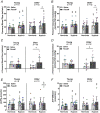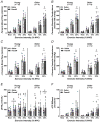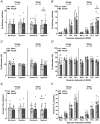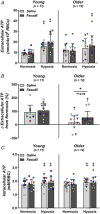Rho-kinase inhibition improves haemodynamic responses and circulating ATP during hypoxia and moderate intensity handgrip exercise in healthy older adults
- PMID: 35575293
- PMCID: PMC9288513
- DOI: 10.1113/JP282730
Rho-kinase inhibition improves haemodynamic responses and circulating ATP during hypoxia and moderate intensity handgrip exercise in healthy older adults
Abstract
Skeletal muscle haemodynamics and circulating adenosine triphosphate (ATP) responses during hypoxia and exercise are blunted in older (OA) vs. young (YA) adults, which may be associated with impaired red blood cell (RBC) ATP release. Rho-kinase inhibition improves deoxygenation-induced ATP release from OA isolated RBCs. We tested the hypothesis that Rho-kinase inhibition (via fasudil) in vivo would improve local haemodynamic and ATP responses during hypoxia and exercise in OA. Healthy YA (25 ± 3 years; n = 12) and OA (65 ± 5 years; n = 13) participated in a randomized, double-blind, placebo-controlled, crossover study on two days (≥5 days between visits). A forearm deep venous catheter was used to administer saline/fasudil and sample venous plasma ATP ([ATP]V ). Forearm vascular conductance (FVC) and [ATP]V were measured at rest, during isocapnic hypoxia (80% ), and during graded rhythmic handgrip exercise that was similar between groups (5, 15 and 25% maximum voluntary contraction (MVC)). Isolated RBC ATP release was measured during normoxia/hypoxia. With saline, ΔFVC was lower (P < 0.05) in OA vs. YA during hypoxia (∼60%) and during 15 and 25% MVC (∼25-30%), and these impairments were abolished with fasudil. Similarly, [ATP]V and ATP effluent responses from normoxia to hypoxia and rest to 25% MVC were lower in OA vs. YA and improved with fasudil (P < 0.05). Isolated RBC ATP release during hypoxia was impaired in OA vs. YA (∼75%; P < 0.05), which tended to improve with fasudil in OA (P = 0.082). These data suggest Rho-kinase inhibition improves haemodynamic responses to hypoxia and moderate intensity exercise in OA, which may be due in part to improved circulating ATP. KEY POINTS: Skeletal muscle blood flow responses to hypoxia and exercise are impaired with age. Blunted increases in circulating ATP, a vasodilator, in older adults may contribute to age-related impairments in haemodynamics. Red blood cells (RBCs) are a primary source of circulating ATP, and treating isolated RBCs with a Rho-kinase inhibitor improves age-related impairments in deoxygenation-induced RBC ATP release. In this study, treating healthy older adults systemically with the Rho-kinase inhibitor fasudil improved blood flow and circulating ATP responses during hypoxia and moderate intensity handgrip exercise compared to young adults, and also tended to improve isolated RBC ATP release. Improved blood flow regulation with fasudil was also associated with increased skeletal muscle oxygen delivery during hypoxia and exercise in older adults. This is the first study to demonstrate that Rho-kinase inhibition can significantly improve age-related impairments in haemodynamic and circulating ATP responses to physiological stimuli, which may have therapeutic implications.
Keywords: ATP; ageing; blood flow; exercise; fasudil; hypoxia.
© 2022 The Authors. The Journal of Physiology published by John Wiley & Sons Ltd on behalf of The Physiological Society.
Figures





Comment in
-
Targeting red cell-derived ATP signalling to improve the aged muscle circulation.J Physiol. 2022 Jul;600(14):3215-3216. doi: 10.1113/JP283322. Epub 2022 Jul 2. J Physiol. 2022. PMID: 35716371 No abstract available.
-
Age-related impairments in ATP release by red blood cells as an important contributor to declines in skeletal muscle blood flow in older adults.J Physiol. 2022 Aug;600(16):3643-3645. doi: 10.1113/JP283367. Epub 2022 Jul 21. J Physiol. 2022. PMID: 35818302 Free PMC article. No abstract available.
Similar articles
-
Reduced deformability contributes to impaired deoxygenation-induced ATP release from red blood cells of older adult humans.J Physiol. 2019 Sep;597(17):4503-4519. doi: 10.1113/JP278338. Epub 2019 Jul 27. J Physiol. 2019. PMID: 31310005 Free PMC article.
-
Modulation of postjunctional α-adrenergic vasoconstriction during exercise and exogenous ATP infusions in ageing humans.J Physiol. 2011 May 15;589(Pt 10):2641-53. doi: 10.1113/jphysiol.2010.204081. Epub 2011 Feb 28. J Physiol. 2011. PMID: 21486772 Free PMC article.
-
Augmentation of endothelium-dependent vasodilatory signalling improves functional sympatholysis in contracting muscle of older adults.J Physiol. 2020 Jun;598(12):2323-2336. doi: 10.1113/JP279462. Epub 2020 May 14. J Physiol. 2020. PMID: 32306393
-
ATP as a mediator of erythrocyte-dependent regulation of skeletal muscle blood flow and oxygen delivery in humans.J Physiol. 2012 Oct 15;590(20):5001-13. doi: 10.1113/jphysiol.2012.235002. Epub 2012 Jun 18. J Physiol. 2012. PMID: 22711955 Free PMC article. Review.
-
Effects of Hypoxia on Erythrocyte Membrane Properties-Implications for Intravascular Hemolysis and Purinergic Control of Blood Flow.Front Physiol. 2017 Dec 22;8:1110. doi: 10.3389/fphys.2017.01110. eCollection 2017. Front Physiol. 2017. PMID: 29312010 Free PMC article. Review.
Cited by
-
Rho-kinase inhibition reduces systolic blood pressure and forearm vascular resistance in healthy older adults: a double-blind, randomized, placebo-controlled pilot study.Geroscience. 2024 Dec;46(6):6317-6329. doi: 10.1007/s11357-024-01240-x. Epub 2024 Jun 18. Geroscience. 2024. PMID: 38888876 Free PMC article. Clinical Trial.
-
Age-related impairments in ATP release by red blood cells as an important contributor to declines in skeletal muscle blood flow in older adults.J Physiol. 2022 Aug;600(16):3643-3645. doi: 10.1113/JP283367. Epub 2022 Jul 21. J Physiol. 2022. PMID: 35818302 Free PMC article. No abstract available.
References
-
- Banzett, R. B. , Garcia, R. T. , & Moosavi, S. H. (2000). Simple contrivance “clamps” end‐tidal PCO2 and PO2 despite rapid changes in ventilation. Journal of Applied Physiology, 88(5), 1597–1600. - PubMed
-
- Barrett‐O'Keefe, Z. , Ives, S. J. , Trinity, J. D. , Morgan, G. , Rossman, M. J. , Donato, A. J. , Runnels, S. , Morgan, D. E. , Gmelch, B. S. , Bledsoe, A. D. , Richardson, R. S. , & Wray, D. W. (2015). Endothelin‐A‐mediated vasoconstriction during exercise with advancing age. Journals of Gerontology Biological Sciences, 70(5), 554–565. - PMC - PubMed
-
- Benjamin, E. , Blaha, M. J. , Chiuve, S. E. , Cushman, M. , Das, S. R. , Deo, R. , de Ferranti, S. D. , Floyd, J. , Fornage, M. , Gillespie, C. , Isasi, C. R. , Jiménez, M. C. , Jordan, L. C. , Judd, S. E. , Lackland, D. , Lichtman, J. H. , Lisabeth, L. , Liu, S. , Longenecker, C. T. , … Muntner, P. , American Heart Association Statistics Committee and Stroke Statistics Subcommittee (2017). Heart disease and stroke statistics—2017 update: A report from the American Heart Association. Circulation, 135(10), e146–e603. - PMC - PubMed
-
- Bergfeld, G. , & Forrester, T. (1992). Release of ATP from human erythrocytes in response to a brief period of hypoxia and hypercapnia. Cardiovascular Research, 26(1), 40–47. - PubMed
-
- Blitzer, M. L. , Lee, S. D. , & Creager, M. A. (1996). Endothelium‐derived nitric oxide mediates hypoxic vasodilation of resistance vessels in humans. American Journal of Physiology, 271, H1182–H1185. - PubMed
Publication types
MeSH terms
Substances
Grants and funding
LinkOut - more resources
Full Text Sources

